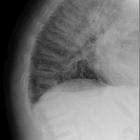Nebenschilddrüsenadenom
































Parathyroid adenomas are benign tumors of the parathyroid glands and are the most common cause of primary hyperparathyroidism.
Clinical presentation
Patients present with primary hyperparathyroidism: elevated serum calcium levels and elevated serum parathyroid hormone levels. This results in multisystem effects including osteoporosis, renal calculi, constipation, peptic ulcers, mental changes, fatigue, and depression.
Pathology
They are usually oval or bean-shaped, but larger adenomas can be multilobulated. The vast majority (up to 87% ) of adenomas occur as solitary lesions.
Location
The majority of parathyroid adenomas are juxtathyroid and located immediately posterior or inferior to the thyroid gland. Superior gland parathyroid adenomas may lie posteriorly in the tracheo-esophageal groove, paraesophageal location, or even as inferior as the mediastinum .
Up to 5% of parathyroid adenomas can occur in ectopic locations. Common ectopic locations include :
- mediastinum
- retropharyngeal
- carotid sheath
- intrathyroidal
Variants
- parathyroid lipoadenoma
Serology
Parathyroid hormone levels are usually elevated (usual normal reference range 1.6-6.9 pmol/L or 10 to 55 pg/mL).
Radiographic features
Ultrasound
Ultrasound is one of the most commonly used initial imaging modalities.
Greyscale
- most nodules need to be >1 cm to be confidently seen on ultrasound
- parathyroid adenomas tend to be homogeneously hypoechoic vs the overlying thyroid gland
- an echogenic thyroid capsule separating the thyroid from the parathyroid may be seen
Doppler ultrasound
Doppler ultrasound can commonly show a characteristic extrathyroidal feeding vessel (typically a branch off the inferior thyroidal artery ), which enters the parathyroid gland at one of the poles. Internal vascularity is also commonly seen in a peripheral distribution. This feeding artery tends to branch around the periphery of the gland before penetration. This feature can give a characteristic arc or rim of vascularity. The overlying thyroid gland may also show an area of asymmetric hypervascularity that may help to locate an underlying adenoma.
Nuclear medicine
SPECT and planar scintigraphy using Tc-99m sestamibi (most common) or Tc-99m tetrofosmin can help localize parathyroid lesions, which show high radiotracer uptake. Fusion SPECT-CT can further aid anatomic localization.
18F-fluorocholine PET/CT may also have a role .
CT
CT can detect suspected ectopic glands (often mediastinal), such as in the case of failed parathyroidectomy . However, in recent years, 4D parathyroid CT has emerged as valuable modality in the era of minimally-invasive parathyroidectomy to precisely localize adenomas preoperatively. 4D CT has been shown to be more sensitive than sonography and scintigraphy for preoperative localization of parathyroid adenomas .
See the separate article on 4D parathyroid CT for an approach to interpretation and the imaging appearance of parathyroid lesions. The classic pattern of parathyroid adenomas, with intense enhancement on arterial phase, washout of contrast on delayed phase, and low attenuation on non-contrast imaging , is present in only a minority of cases .
Several morphologic features can support the diagnosis of an abnormal parathyroid gland :
- polar vessel sign: an enlarged feeding artery or draining vein leading to the end of a hypervascular parathyroid [pattern - most neuroendocrine tumors (eg carcinoid, paraganglioma, carotid body tumor, pheochromocytoma etc) are hypervascular]
- larger lesion: single adenomas tend to be larger than multiglandular disease and size increases diagnostic confidence
- on non contrast imaging - iodine deplete (compared to thyroid, so is less dense)
MRI
MRI is infrequently utilized in initial workup because of lower spatial resolution and artifacts. Adenomas can show variable signal intensity on MRI. Reported signal characteristics include:
- T1
- typically intermediate to low signal
- subacute hemorrhage can cause high signal intensity
- fibrosis or old hemorrhage can cause low signal intensity
- T2
- typically hyperintense
- subacute hemorrhage can cause high signal intensity
- fibrosis or old hemorrhage can cause low signal intensity
Since most lesions demonstrate high T2 signal intensity, the addition of contrast for MRI does not significantly increase detection.
Treatment and prognosis
Surgery is successful in treating primary hyperparathyroidism caused by parathyroid adenomas in 95-98% of cases .
Differential diagnosis
For a non-ectopic adenoma on ultrasound, consider:
- parathyroid hyperplasia
- eccentric thyroid nodule
- sequestered thyroid tissue
- lymph node
- vessel
Siehe auch:
und weiter:

 Assoziationen und Differentialdiagnosen zu Nebenschilddrüsenadenom:
Assoziationen und Differentialdiagnosen zu Nebenschilddrüsenadenom:

